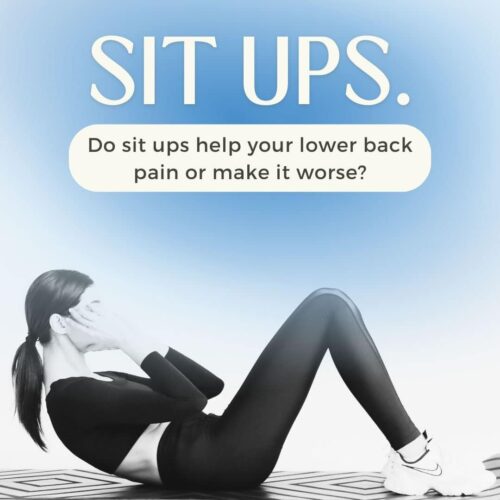Do sit-ups help your lower back pain or make it worse?
Sit-ups are a great way to strengthen your core.
However, if done excessively and incorrectly, sit-ups can also exacerbate your back pain!
Doing sit-ups with back pain comes with multiple risks. These include:
- Compression of the Spine – lifting your upper body toward your knees during a sit-up can place compressive pressure on your spine, potentially causing discomfort
- Straining of Back Muscles – lifting your head to your knees, particularly when you have a weak core, causes the muscles surrounding your spine to strain and tense. Additionally, failing to rest between sit-up exercises can also aggravate lower back pain
- Risk of Herniated Disc – flexing of the spine can place stress on the outer edge of the spine which could eventually result in disc bulge, herniated disc, or nerve pain
- Tilting Pelvis Anteriorly – the contraction of your hip-flexor muscle when doing sit-ups can cause your pelvis to tilt forward. If the muscle tilts too far forward, this can cause lower back pain
Despite these risks, there are many ways to do your sit-ups correctly! It is always important to warm up your body prior to any exercise to increase blood flow and muscle elasticity. This can include rolling your shoulders, arm circles and jumping jacks. When doing sit-ups, it is pivotal to be mindful of your form. Lay flat on your back, with your knees bent and feet flat on the floor. Place your hands carefully behind your head, ensuring when you sit up you contract your abdominal muscles rather than pulling your neck, as this will strain your cervical and shoulder muscles.
If you are not comfortable with doing sit-ups and feel it may aggravate your back pain, some alternatives consist of:
- Hamstring Stretches – Hamstring stretches are a great way to alleviate tension in the back of your leg and lower spine. You can find effective hamstring exercises (link in bio) here:
.
- Bird Dog – Bird dog improves balance, mobility, and muscular strength, particularly in your core. To do this exercise, begin in a quadruped position. Retract your head slightly, engage your abs, and squeeze your glutes. Whilst doing this, reach your right arm forward and left leg back. Repeat on the other side.
- Wall Sits – Wall sits help build muscular endurance, particularly in your quad and core. Start by engaging in a sitting position against a wall, with your feet shoulder-width apart and thighs parallel to the ground. Hold the position for 20-60 seconds, rest for 30 seconds, and then repeat.
- Plank – Planks benefit postural integrity and upper back muscle strength. Set up in a quadruped position. Begin in the plank position with your hands and toes on the floor. Ensure your shoulders are stacked slightly over your wrists. Your head should be relaxed and facing the floor. Keep your body straight in its neutral spine position and engage your abdominal muscles. Slide your heels so they are over the balls of your feet. Maintain this position for 15-20 seconds and then rest, slowly building up to one-minute planks.
- Scissor Kick – Scissor kicks effectively alleviate pressure off the lower back. Lie on your back with your arms by your sides. Tuck your chin and lift both legs up to a 45-degree angle. Squeeze your glutes cross your right foot over to your left, and repeat for the other side. Maintain this for 30 seconds, then rest and repeat
When completing these sit-ups or alternate exercises, it’s important only to do what you are comfortable with, as pushing yourself too far can exacerbate back strain and discomfort!
If your back pain persists, we recommend you see one of our chiropractors. To book a consultation, please get in touch with us on (02) 9588 7000 or book online here.






